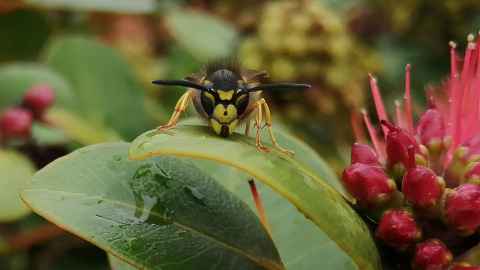Wasps buzz off when there are more trees – study
28 January 2020
Lush forest cover and limited human habitation mean fewer invasive wasps, new research on New Zealand’s offshore islands shows.

A study on 36 islands off the east coast of the North Island has found low numbers of invasive wasps on islands with better forest cover but high numbers on islands where farming is a significant activity and where high densities of exotic weeds and plants have replaced native forest.
The study found invasive wasps on 35 out of 36 islands with the highest mean abundance of common and German wasps – 78 wasps per five minute count – found on Great Mercury Island off the Coromandel Peninsula and the highest mean abundance of paper wasps – 33 per five minute count - on Rotoroa Island in the Hauraki Gulf.
Lead author of the study, Julia Schmack, a PhD student at University of Auckland’s School of Biological Sciences, says wasps are attracted to open grassland with plenty of sunlight and they also like areas of exotic plants.
“Sunlight helps them to warm up and stay active, so areas that are shaded by canopy are not favourable for them, whereas open areas of pasture land are,” she says.
“Also, the first plants that grow in areas where forest has been cut down are often exotic weeds and we think some of these may provide better food resources for invasive wasps than native plants.”
There are five species of introduced social wasps in New Zealand: the German and the common wasp, Vespula germanica and Vespula vulgaris, and three species of paper wasp or Polistes, the Asian and Australian paper wasp, as well as the more recently introduced European paper wasp. Social wasps have been particularly successful in New Zealand since introduction, but very little was known about wasps on New Zealand’s offshore islands, she says.
Researchers used GPS technology to randomly assign survey points on each island and adapted standard science methods used for bird counts to estimate wasp numbers.
The study found Aorangi Island, part of the Poor Knights nature reserve northeast of Whangārei, had no wasps. In contrast, two of New Zealand’s best-known wildlife sanctuaries, Tiritiri Matangi Island and Te Hauturu-O-Toi (Little Barrier Island) in the Hauraki Gulf, were free of German and common wasps, but had relatively high numbers of paper wasps.
Introduced social wasps cause big problems for native species, including some endangered species. Invasive wasps compete for nectar and honeydew and are a particular problem in South Island beech forests where they consume massive amounts of honeydew, which would otherwise be available for native birds, bats, insects and lizards.
Wasps also eat native insects and drastically reduce the survival chances of native orb-web spiders.
Researchers say there is one type of forest which is an exception to this study’s findings and that is forest infested with high densities of native scale insects that produce honeydew. Honeydew is a vital food for many native birds but wasps consume large amounts of it to the detriment of native birds.
Ms Schmack says the study provides new and important insights that may help control invasive wasps in New Zealand, particularly on offshore islands with endemic wildlife. If there were more forests, it would likely reduce wasp numbers. Re-planting with native trees is an obvious strategy to enhance habitat for native species.
“It’s important to look at the whole ecosystem and the influence humans have on it to better understand invasive wasps,” she says. “A more holistic approach to managing invasive species is also likely to be more sustainable in terms of resource use and conservation gains.”
The research team included scientists from the University of Auckland, Manaaki Whenua-Landcare Research and the Biodiversity and Climate Research Centre in Frankfurt, Germany and is published in the journal Diversity and Distributions.
Media contact
Anne Beston | Media adviser
DDI 09 923 3258
Mob 021 970 089
Email a.beston@auckland.ac.nz